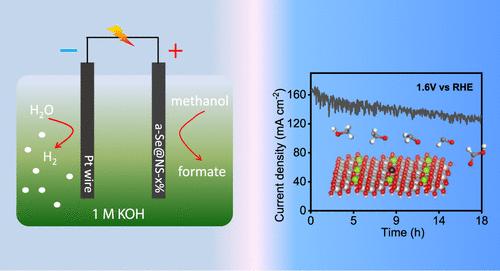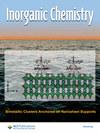Surface Selenium Coating Promotes Selective Methanol-to-Formate Electrooxidation on Ni3Se4 Nanoparticles
IF 4.3
2区 化学
Q1 CHEMISTRY, INORGANIC & NUCLEAR
引用次数: 0
Abstract
In the quest to replace fossil fuels and reduce carbon dioxide emissions, developing energy technologies based on clean catalytic processes is fundamental. However, the cost-effectiveness of these technologies strongly relies on the availability of efficient catalysts made of abundant elements. Herein, this study presents a one-step hydrothermal method to obtain a series of Ni3Se4 nanoparticles with a layer of amorphous selenium on their surface. When employed as electrocatalysts for the methanol oxidation reaction (MOR), the optimized proper surface Se-coated Ni3Se4 nanoparticles exhibit a high current density of 160 mA cm–2 at 1.6 V, achieving a high methanol-to-formate Faradaic efficiency above 97.8% and excellent stability with less than 20% current decay after an 18 h chronoamperometry test. This excellent performance is rationalized using density functional theory calculations, which unveil that the electrochemical recombination of SeOx results in a reduction of the energy barrier for the dehydrogenation of methanol during the MOR process.

表面硒涂层促进 Ni3Se4 纳米粒子上甲醇对甲酸酯的选择性电氧化作用
在寻求替代化石燃料和减少二氧化碳排放的过程中,开发基于清洁催化过程的能源技术至关重要。然而,这些技术的成本效益在很大程度上取决于能否获得由丰富元素制成的高效催化剂。在此,本研究提出了一种一步水热法,以获得一系列表面带有一层无定形硒的 Ni3Se4 纳米粒子。在用作甲醇氧化反应(MOR)的电催化剂时,经过优化的适当表面硒镀层 Ni3Se4 纳米粒子在 1.6 V 的电压下表现出 160 mA cm-2 的高电流密度,实现了高于 97.8% 的甲醇-甲酸法拉第效率,并且在 18 小时计时器测试后电流衰减小于 20% 的优异稳定性。密度泛函理论计算揭示了 SeOx 的电化学重组可降低 MOR 过程中甲醇脱氢的能量势垒,从而使这一优异性能更加合理。
本文章由计算机程序翻译,如有差异,请以英文原文为准。
求助全文
约1分钟内获得全文
求助全文
来源期刊

Inorganic Chemistry
化学-无机化学与核化学
CiteScore
7.60
自引率
13.00%
发文量
1960
审稿时长
1.9 months
期刊介绍:
Inorganic Chemistry publishes fundamental studies in all phases of inorganic chemistry. Coverage includes experimental and theoretical reports on quantitative studies of structure and thermodynamics, kinetics, mechanisms of inorganic reactions, bioinorganic chemistry, and relevant aspects of organometallic chemistry, solid-state phenomena, and chemical bonding theory. Emphasis is placed on the synthesis, structure, thermodynamics, reactivity, spectroscopy, and bonding properties of significant new and known compounds.
 求助内容:
求助内容: 应助结果提醒方式:
应助结果提醒方式:


